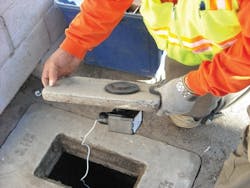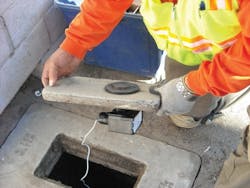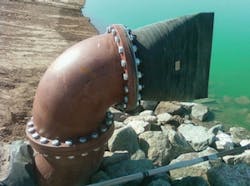Increasingly, water supplies are dwindling and populations are growing. Water utilities all over the world are faced with meeting demands with alternative approaches, such as desalination. However, the industry is still researching technologies and conducting treatment evaluations to maximize the effectiveness and efficiency of desalination in addressing water scarcity.
Whether dealing with seawater or brackish water, treatment considerations include concentrate disposal, cost, energy efficiency and regulatory requirements, among others. At the American Water Works Association’s 2011 Annual Conference & Exposition, presenters from the engineering firm CDM are addressing some of these issues.
Brine, Salt Recovery
Desalination processes generate significant quantities of concentrate that contains high levels of total dissolved solids, which are almost exclusively inorganic salts and metals. The beneficial use of concentrate is being considered as a possible option to offset the cost of concentrate disposal. Access to existing and future salt markets may provide operators of desalination facilities with revenue sources that might compensate for high operating, transportation and market access costs.
In “Marketability and Selective Recovery Methods for Concentrate Brine and Salts from Brackish Water Desalination,” a discussion of the six sparingly soluble and recoverable salts generated from brackish water supplies using reverse osmosis (RO) will be presented, including calcium carbonate, calcium sulfate, sodium sulfate, sodium carbonate, sodium chloride and calcium chloride. The characteristics and possible uses of the recoverable salts for a utility operating a desalination plant will be explored.
The presentation will include market analysis of the six salts identified, including product information and market trends, purity requirements and obstacles to using these salts produced from RO concentrate. Treatment processes that have the potential for selectively recovering salts from RO concentrate and research being conducted by the University of New Mexico on a possible ion exchange process for selective salt recovery will also be discussed.
Treatment and Usable Byproducts – A Pilot Study
A second presentation addressing salt recovery is “Salt Production from a Potable Water Supply – Pilot Study Results,” a summary of a pilot study conducted for Sandoval County Water Department (New Mexico) to investigate treatment of a saline groundwater for potable water use. The pilot testing also considered possible production of usable byproducts from the waste streams to reduce disposal costs and offset operating costs of the proposed desalination facility.
The artesian groundwater being considered by Sandoval County contains 12,000 milligrams per liter of total dissolved solids with extremely high levels of calcium, magnesium, arsenic and boron, in addition to radionuclides and a temperature of 150 degrees Fahrenheit. To remove these contaminants, a process treatment approach was developed using a combination of coagulation, chemical softening, media filtration, ion exchange and reverse osmosis to produce potable water. It also created three distinct waste streams, two of which could produce saleable byproducts.
Pilot testing confirmed that calcium can be effectively removed, maintaining a relatively pure calcium carbonate waste stream that can potentially be recovered, recalcinated and reused in the treatment process. RO waste streams were found to contain primarily sodium chloride and sodium sulfate, which can be separated from each other using nanofiltration to produce high purity salt product streams. The presentation will explore how the successful pilot testing—which achieved 80-percent RO recovery—is now guiding the county as it plans to produce a new water supply by treating saline groundwater.
Regulatory Acceptance in California
As U.S. coastal communities increasingly consider seawater as a potable water supply, regulators are challenged with ensuring that desalination treatment will produce safe, reliable water for the public. In “Achieving Regulatory Acceptance of Seawater Treatment,” four California seawater desalination projects will be discussed—in the cities of Sand City, Santa Cruz, Dana Point and Cambria—as well as their individual approaches for treatment and meeting regulatory compliance.
Permitting challenges will be addressed, including:
- Classifying subsurface intakes as groundwater, groundwater under the direct influence of surface water, or as impaired surface water
- Achieving the required log removal credits for Giardia, Cryptosporidium and viruses
- Performing integrity monitoring of RO membranes
- Obtaining National Sanitation Foundation-approved materials that are compatible with seawater
- Developing and achieving boron goals
- Providing adequate product water stabilization
The presentation will provide updates on each of the facilities’ proposed or implemented treatment approaches, water quality performance and regulatory status—assisting utilities, regulators and consultants in identifying and addressing health and safety concerns associated with seawater treatment for potable water supply.
Robert Fowlie, a principal environmental engineer in CDM’s Albuquerque, New Mexico, office, will present “Marketability and Selective Recovery Methods for Concentrate Brine and Salts from Brackish Water Desalination,” on Wednesday, June 15, at 8:45 a.m.
Greg Wetterau, an associate and environmental engineer in CDM’s Rancho Cucamonga office will present “Salt Production from a Potable Water Supply – Pilot Study Results,” on June 15 at 9:15 a.m. and “Achieving Regulatory Acceptance of Seawater Treatment” on June 14 at 4:00 p.m.
Circle No. 393 on Reader Service Card
More WaterWorld Current Issue Articles
More WaterWorld Archives Issue Articles





